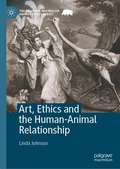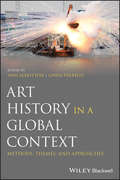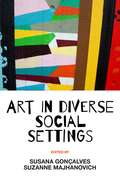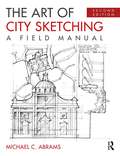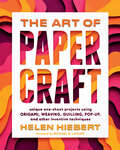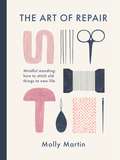- Table View
- List View
Art Class: How to Create Your Own Artwork (Art Class)
by Barrington BarberAn essential guide to drawing by internationally bestselling practical art author Barrington Barber.Whether you want to learn to draw from scratch or to brush up your skills, this comprehensive drawing manual contains all you need. With introductory chapters on techniques, basic drawing exercises and composition, the book goes on to explore the major subject areas available to you as an artist: still life, landscape, and figure drawing.Barrington Barber's combination of clear step-by-step exercises and inspirational examples has enabled people all over the world to learn to draw, and to enjoy this incredibly rewarding pastime.ABOUT THE SERIES: Arcturus' Art Class books are a curated series of instructional art and craft titles designed to inspire artists of all levels, from beginner to professional. Stunningly presented in full color and in a highly usable landscape format, these comprehensive books are packed with all the ideas, inspirations, step-by-step projects, and techniques you'll need to master the subject covered.
Art/Commons: Anthropology beyond Capitalism (In Common)
by Massimiliano MollonaArt/Commons is the first book to theorise the commons from the perspectives of contemporary art history and anthropology, focusing on the ongoing tensions between art and capitalism. This study is grounded in an analysis of contemporary artistic and curatorial practices, which the author describes as practices of commoning, based on co-production, participation, mutualism and the valorization of reproductive labour. Mollona proposes a novel theoretical approach to current debates on the commons, and shows that art can provide both a language of anti-capitalist and post-colonial critique as well as a distinctive set of skills and practices of commoning.
Art Conservation: Mechanical Properties and Testing of Materials
by W. (Bill) WeiConservators and other museum professionals face a large number of issues involving the mechanical behavior of materials, including questions on craquelure, restoring physically damaged objects, art in transport, or the selection of adhesives. However, science in conservation and museum studies curricula focusses mostly on chemistry. This book fills this important gap in conservation training. It is the first such book written specifically for the conservation community and professionals with little or no background in (mechanical) engineering. It introduces the basics of mechanical properties and behavior of materials and objects with examples and exercises based on conservation practice. More complex issues of mechanical loading and advanced solutions are also introduced.
Art Conservation: Mechanical Properties and Testing of Materials
by W. (Bill) WeiConservators and other museum professionals face a large number of issues involving the mechanical behavior of materials, including questions on craquelure, restoring physically damaged objects, art in transport, or the selection of adhesives. However, science in conservation and museum studies curricula focusses mostly on chemistry. This book fills this important gap in conservation training. It is the first such book written specifically for the conservation community and professionals with little or no background in (mechanical) engineering. It introduces the basics of mechanical properties and behavior of materials and objects with examples and exercises based on conservation practice. More complex issues of mechanical loading and advanced solutions are also introduced.
Art, Ethics and the Human-Animal Relationship (The Palgrave Macmillan Animal Ethics Series)
by Linda JohnsonThis book examines the works of major artists between the seventeenth and nineteenth centuries, as important barometers of individual and collective values toward non-human life. Once viewed as merely representational, these works can also be read as tangential or morally instrumental by way of formal analysis and critical theories. Chapter Two demonstrates the discrimination toward large and small felines in Genesis and The Book of Revelation. Chapter Three explores the cruel capture of free roaming animals and how artists depicted their furs, feathers and shells in costume as symbols of virtue and vice. Chapter Four identifies speciest beliefs between donkeys and horses. Chapter Five explores the altered Dutch kitchen spaces and disguised food animals in various culinary constructs in still life painting. Chapter Six explores the animal substances embedded in pigments. Chapter Seven examines animals in absentia-in the crafting of brushes. The book concludes with the fish paintings of William Merritt Chase whose glazing techniques demonstrate an artistic approach that honors fishes as sentient beings.
Art History: The Basics (The Basics)
by Diana Newall Grant PookeNow in its second edition, this volume is an accessible introduction to the history of art. Using an international range of examples, it provides the reader with a toolkit of concepts, ideas and methods relevant to understanding art history. This new edition is fully updated with colour illustrations, increased coverage of non-western art and extended discussions of contemporary art theory. It introduces key ideas, issues and debates, exploring questions such as: What is art and what is meant by art history? What approaches and methodologies are used to interpret and evaluate art? How have ideas regarding medium, gender, identity and difference informed representation? What perspectives can psychoanalysis, semiotics and social art histories bring to the study of the discipline? How are the processes of postcolonialism, decolonisation and globalisation changing approaches to art history? Complete with helpful subject summaries, a glossary, suggestions for future reading and guidance on relevant image archives, this book is an ideal starting point for anyone studying art history as well as general readers with an interest in the subject.
Art History: The Basics (The Basics)
by Diana Newall Grant PookeNow in its second edition, this volume is an accessible introduction to the history of art. Using an international range of examples, it provides the reader with a toolkit of concepts, ideas and methods relevant to understanding art history. This new edition is fully updated with colour illustrations, increased coverage of non-western art and extended discussions of contemporary art theory. It introduces key ideas, issues and debates, exploring questions such as: What is art and what is meant by art history? What approaches and methodologies are used to interpret and evaluate art? How have ideas regarding medium, gender, identity and difference informed representation? What perspectives can psychoanalysis, semiotics and social art histories bring to the study of the discipline? How are the processes of postcolonialism, decolonisation and globalisation changing approaches to art history? Complete with helpful subject summaries, a glossary, suggestions for future reading and guidance on relevant image archives, this book is an ideal starting point for anyone studying art history as well as general readers with an interest in the subject.
Art History in a Global Context: Methods, Themes, and Approaches
by Ann Albritton Gwen FarrellyPresents a clear and comprehensive introduction to the evolving discipline of global art studies This volume examines how art historians, critics, and artists revisit art from ancient times through to the early modern period as well as the ways in which contemporary objects are approached through the lens of global contact, exchange, networks, and trade routes. It assists students who actively seek to understand "global art history" and the discipline beyond the founding Western canons. The first section of Art History in a Global Context: Methods, Themes and Approaches explores how themes related to globalization are framing the creation, circulation, reception, and study of art today. The second section examines how curators, scholars, artists, and critics have challenged the Eurocentric canon through works of art, writings, exhibitions, biennials, large-scale conferences, and the formation of global networks. The third section is designed to help students look forward by exploring how art history in a global context is beginning to extend beyond the contemporary condition to understand the meaning, conditions, and impacts of exchange across borders and among artists in earlier periods. Presents a historiography of global art histories in academic, museological, and exhibition projects Written by a collection of authors from different linguistic, cultural, geographic, generational, and disciplinary perspectives Aids students in understanding “global art history” and the discipline beyond the founding Western canons Provides a set of case studies to bring to life methodologies being employed in the field Features contributors from the program of the Getty Foundation and the College Art Association International Committee’s project Art History in a Global Context is an ideal choice for upper-level undergraduate and entry level graduate art students. It can also be used as a teaching tool, or as models for case studies in different formats.
Art History in a Global Context: Methods, Themes, and Approaches
by Ann Albritton and Gwen FarrellyPresents a clear and comprehensive introduction to the evolving discipline of global art studies This volume examines how art historians, critics, and artists revisit art from ancient times through to the early modern period as well as the ways in which contemporary objects are approached through the lens of global contact, exchange, networks, and trade routes. It assists students who actively seek to understand "global art history" and the discipline beyond the founding Western canons. The first section of Art History in a Global Context: Methods, Themes and Approaches explores how themes related to globalization are framing the creation, circulation, reception, and study of art today. The second section examines how curators, scholars, artists, and critics have challenged the Eurocentric canon through works of art, writings, exhibitions, biennials, large-scale conferences, and the formation of global networks. The third section is designed to help students look forward by exploring how art history in a global context is beginning to extend beyond the contemporary condition to understand the meaning, conditions, and impacts of exchange across borders and among artists in earlier periods. Presents a historiography of global art histories in academic, museological, and exhibition projects Written by a collection of authors from different linguistic, cultural, geographic, generational, and disciplinary perspectives Aids students in understanding “global art history” and the discipline beyond the founding Western canons Provides a set of case studies to bring to life methodologies being employed in the field Features contributors from the program of the Getty Foundation and the College Art Association International Committee’s project Art History in a Global Context is an ideal choice for upper-level undergraduate and entry level graduate art students. It can also be used as a teaching tool, or as models for case studies in different formats.
Art in Diverse Social Settings
by Susana Gonçalves Suzanne MajhanovichThis edited collection examines the important and multi-varied role that art plays in today's diverse society. Art is linked to the worldviews and mind-sets from which it results and, as a complex and ambiguous product of culture and perception, it can only be truly understood from multiple perspectives. Recognising this, Art in Diverse Social Settings brings together contributions from a diverse range of authors - including scholars and artists from different countries, artistic languages and art statements - to give fresh perspectives on central questions such as: What purpose(s) do the arts serve in contemporary diverse and pluralistic societies? What are the links between art and citizenship in a 'glocal' perspective? Can aesthetics be compared to faith, therapy or civic resistance? Is art a feasible tool to prevent and contest social injustice, raise social consciousness and resistance in the political arena? Can art promote social inclusion? How can artistic practices contribute to community development? The book contains three parts including Part 1 with theoretical chapters, and Parts 2 and 3 that present exemplary case studies illustrating art as a medium for communication and intervention in professional organizations, public spaces and/or the community.
Art in Diverse Social Settings
by Susana Gonçalves Suzanne MajhanovichThis edited collection examines the important and multi-varied role that art plays in today's diverse society. Art is linked to the worldviews and mind-sets from which it results and, as a complex and ambiguous product of culture and perception, it can only be truly understood from multiple perspectives. Recognising this, Art in Diverse Social Settings brings together contributions from a diverse range of authors - including scholars and artists from different countries, artistic languages and art statements - to give fresh perspectives on central questions such as: What purpose(s) do the arts serve in contemporary diverse and pluralistic societies? What are the links between art and citizenship in a 'glocal' perspective? Can aesthetics be compared to faith, therapy or civic resistance? Is art a feasible tool to prevent and contest social injustice, raise social consciousness and resistance in the political arena? Can art promote social inclusion? How can artistic practices contribute to community development? The book contains three parts including Part 1 with theoretical chapters, and Parts 2 and 3 that present exemplary case studies illustrating art as a medium for communication and intervention in professional organizations, public spaces and/or the community.
Art in the Cinema: The Mid-Century Art Documentary
by Edited by Steven Jacobs, Birgit Cleppe and Dimitrios LatsisIn the 1940s and 1950s, hundreds of art documentaries were produced, many of them being highly personal, poetic, reflexive and experimental films that offer a thrilling cinematic experience. With the exception of Alain Resnais's Van Gogh (1948), Henri-Georges Clouzot's Le Mystère Picasso (1956) and a few others, most of them have received only scant scholarly attention. This book aims to rectify this situation by discussing the most lyrical, experimental and influential post-war art documentaries, connecting them to contemporaneous museological developments and Euro-American cultural and political relationships. With contributors with expertise across art history and film studies, Art in the Cinema draws attention to film projects by André Bazin, Ilya Bolotowsky, Paul Haesaerts, Carlo Ragghianti, John Read, Dudley Shaw Aston, Henri Storck and Willard Van Dyke among others.
Art in Theory: The West in the World - An Anthology of Changing Ideas
by Paul Wood Leon Wainwright Charles HarrisonArt in Theory: The West in the World is a ground-breaking anthology that comprehensively examines the relationship of Western art to the art and material culture of the wider world. Editors Paul Wood and Leon Wainwright have included over 350 texts, some of which appear in English for the first time. The anthologized texts are presented in eight chronological parts, which are then subdivided into key themes appropriate to each historical era. The majority of the texts are representations of changing ideas about the cultures of the world by European artists and intellectuals, but increasingly, as the modern period develops, and especially as colonialism is challenged, a variety of dissenting voices begin to claim their space, and a counter narrative to western hegemony develops. Over half the book is devoted to 20th and 21st century materials, though the book’s unique selling point is the way it relates the modern globalization of art to much longer cultural histories. As well as the anthologized material, Art in Theory: The West in the World contains: A general introduction discussing the scope of the collection Introductory essays to each of the eight parts, outlining the main themes in their historical contexts Individual introductions to each text, explaining how they relate to the wider theoretical and political currents of their time Intended for a wide audience, the book is essential reading for students on courses in art and art history. It will also be useful to specialists in the field of art history and readers with a general interest in the culture and politics of the modern world.
Art in Theory: The West in the World - An Anthology of Changing Ideas
by Paul Wood Leon Wainwright Charles HarrisonArt in Theory: The West in the World is a ground-breaking anthology that comprehensively examines the relationship of Western art to the art and material culture of the wider world. Editors Paul Wood and Leon Wainwright have included over 350 texts, some of which appear in English for the first time. The anthologized texts are presented in eight chronological parts, which are then subdivided into key themes appropriate to each historical era. The majority of the texts are representations of changing ideas about the cultures of the world by European artists and intellectuals, but increasingly, as the modern period develops, and especially as colonialism is challenged, a variety of dissenting voices begin to claim their space, and a counter narrative to western hegemony develops. Over half the book is devoted to 20th and 21st century materials, though the book’s unique selling point is the way it relates the modern globalization of art to much longer cultural histories. As well as the anthologized material, Art in Theory: The West in the World contains: A general introduction discussing the scope of the collection Introductory essays to each of the eight parts, outlining the main themes in their historical contexts Individual introductions to each text, explaining how they relate to the wider theoretical and political currents of their time Intended for a wide audience, the book is essential reading for students on courses in art and art history. It will also be useful to specialists in the field of art history and readers with a general interest in the culture and politics of the modern world.
The Art of Caregiving in Fiction, Film, and Memoir
by Jeffrey BermanBringing together the human story of care with its representation in film, fiction and memoir, this book combines an analysis of care narratives to inform and inspire ideas about this major role in life. Alongside analysis of narratives drawn from literature and film, the author sensitively interweaves the story of his wife's illness and care to illuminate perspectives on dealing with human decline. Examining texts from a diverse range of authors such as Leo Tolstoy, Edith Wharton and Alice Munro, and filmmakers such as Ingmar Bergman and Michael Haneke, it addresses questions such as why caregiving is a dangerous activity, the ethical problems of writing about caregiving, the challenges of reading about caregiving, and why caregiving is so important. It serves as a fire starter on the subject of how we can gain insight into the challenges and opportunities of caregiving through the creative arts.
The Art of City Sketching: A Field Manual
by Michael C. AbramsThe Art of City Sketching: A Field Manual guides readers through the process of freehand architectural sketching and explains orthographic, diagrammatic, three-dimensional, and perceptual-type drawings. The book presents hundreds of drawings of historic buildings and urban spaces, examples, and exercises, which help readers develop their drawing skills and employ sketching as an analytical tool. The book is divided into three parts, based on the reader’s skill level: beginner, intermediate, and advanced. As an architect and field sketching instructor, the author shows that through drawing the reader can discover, analyze, and comprehend the built environment. The new edition of The Art of City Sketching expands on the drawing techniques of the previous version by adding new drawing examples, exercises, and two new chapters—Chiaroscuro and Storyboard. New drawing tips, demonstrations, and composition "do’s and don’ts" will support readers when they illustrate their viewpoint of the city by using simple drawing tools. The lessons in this book will allow readers to mix method with imagination and sensibility.
The Art of City Sketching: A Field Manual
by Michael C. AbramsThe Art of City Sketching: A Field Manual guides readers through the process of freehand architectural sketching and explains orthographic, diagrammatic, three-dimensional, and perceptual-type drawings. The book presents hundreds of drawings of historic buildings and urban spaces, examples, and exercises, which help readers develop their drawing skills and employ sketching as an analytical tool. The book is divided into three parts, based on the reader’s skill level: beginner, intermediate, and advanced. As an architect and field sketching instructor, the author shows that through drawing the reader can discover, analyze, and comprehend the built environment. The new edition of The Art of City Sketching expands on the drawing techniques of the previous version by adding new drawing examples, exercises, and two new chapters—Chiaroscuro and Storyboard. New drawing tips, demonstrations, and composition "do’s and don’ts" will support readers when they illustrate their viewpoint of the city by using simple drawing tools. The lessons in this book will allow readers to mix method with imagination and sensibility.
The Art of Doris and Anna Zinkeisen
by Philip Kelleway Emma Roodhouse Nicola EvansThis lavishly illustrated book celebrates the life of Doris and Anna Zinkeisen, charting the rise of the sisters from a childhood in Scotland, to their emergence as amongst the most eminent artists of their day in London, to a quieter yet still highly productive life during their twilight years in rural Suffolk. It also marks the recent purchase by the Colchester and Ipswich Museums Service of a glamorous Zinkeisen portrait to add to the Ipswich Borough collections.During the golden age from the 1920s through to the 1950s, the Zinkeisen sisters enjoyed a huge success and won numerous accolades. Their paintings and design work, including posters, murals for luxury ocean liners, and costume designs for stage and film, are today emblematic of that period in British art.
The Art of Dramaturgy
by Anne CattaneoAn introduction to the mysterious theater role of a dramaturg by a legend in the field Anne Cattaneo was among the first Americans to fill the role of dramaturg, one of theater’s best kept secrets. A combination of theater artist, scholar, researcher, play advocate, editor, and writer’s friend, it is the job of a dramaturg to “reflect light back on the elements that are already in play,” while bringing a work of theater to life. Cattaneo traces the field from its beginnings in the eighteenth century to the present and chronicles the multitude and variety of tasks a dramaturg undertakes before, during, and after a production is brought to the stage. Using detailed stories from her work with theater artists such as Tom Stoppard, Wendy Wasserstein, Robert Wilson, Shi-Zheng Chen, and Sarah Ruhl, as well as the discovery of a ‘lost’ play by Langston Hughes and Zora Neale Hurston, Cattaneo provides an invaluable manual to those studying, working in, and interested in this most fascinating profession.
The Art of Papercraft: Unique One-Sheet Projects Using Origami, Weaving, Quilling, Pop-Up, and Other Inventive Techniques
by Helen HiebertPaper artist and teacher Helen Hiebert compiles a one-of-kind collection of 40 unique projects, each using just one sheet of paper. Combining decorative paper techniques like marbling, stamping, and stenciling with dimensional techniques like origami, cutting, folding, quilling, stretching, weaving, and pop-ups, The Art of Papercraft offers a rich variety of projects that will delight crafters, artists, and designers alike, including paper votive lights, pop-up cards, folded paper gift boxes and envelopes, woven paper wall hangings, miniature one-sheet books, and much more. Every project is beautifully photographed and accompanied by step-by-step visual instructions. Guidance on selecting tools, materials, and paper selection; in-depth technique instructions; and profiles of contributing paper artists make this a rich and practical celebration of papercraft. This publication conforms to the EPUB Accessibility specification at WCAG 2.0 Level AA.
The Art of Repair: Mindful mending: how to stitch old things to new life
by Molly MartinFor Molly Martin, it all started with a pair of socks. Her favourite pair. When the heels became threadbare, her mother got out her darning mushroom and showed her how to reinforce the thinning stitches and bring them back to life. She has been stitching and darning ever since.In The Art of Repair, Molly explores the humble origins of repair and how the act of mending a cherished item carefully by hand offers not just a practical solution but nourishment for the soul. Using her own beautiful illustrations, she guides us through the basics of the craft - from piecing and patching to the ancient Japanese art of Sashiko.This book will stay with you long after you put down your needle and thread. It offers an antidote to our increasingly disposable lifestyle, encouraging us to reconnect not just with the everyday objects in our environment but also with ourselves.
The Art of Resonance (Theatre Makers)
by Anne BogartWhat is artistic resonance and how can it be linked to one's life and one's art? This latest book of essays from legendary theatre director Anne Bogart, considers the creation of resonance in the artistic endeavour, with a focus on the performing arts. The word 'resonance' comes from the Latin meaning to 're-sound' or 'sound together'. From music to physics, resonance is a common thread that evokes a response and, in general, is understood as a quality that makes something personally meaningful and valuable.For Bogart, curiosity is a key personal quality to be nurtured throughout life and that very same curiosity, as an artist, thinker and human being. Creating pathways between performance theory, art history, neuroscience, music, architecture and the visual arts, and consistently forging new thought-paths, the writing draws upon Anne Bogart's own life and artistic journeys to illuminate potent philosophical ideas. Woven with personal anecdotes, stories and reflections, this is a book that will be of interest to any theatre artist and anyone who reflects on the power of the arts, of theatre-making and what it means to be engaged in the artistic process.
Art, Politics and the Pamphleteer (Radical Aesthetics-Radical Art)
by Jane Tormey and Gillian WhiteleyArt, Politics and the Pamphleteer brings together a collection of text-based and visual essays, commissioned artworks and graphics. This richly illustrated book responds to the concept, aesthetics and function of the political pamphlet. It is diverse in content, interpreting the 'pamphlet' in the broadest terms, and encompassing a number of case studies that offer historical or specific examples of contemporary pamphleteering practice that can be seen to perform 'a clear political implication' or protest. Besides exploring the radical history and diverse cultures of the pamphlet, it also celebrates the rich visual rhetoric, typography and contemporary relevance of the format for both artists and activists. Contributions include an historical overview and essays by: Andy Abbott, Angeliki Avgitidu, Aziz Choudry and Désirée Rochat, David Murrieta Flores, Michelle Kempson, Pil and Galia Kollectiv, Rachel Schreiber, Jane Tormey, Gillian Whiteley; visual contributions by Gary Anderson and Steven Shakespeare, Ruth Beale, Ami Clarke, Common Culture, Jeremy Deller, Freee, Patrick Goddard, Gavin Grindon, Ferenc Grof, Marc Herbst, Joanne Lee, Josh MacPhee, Manual Labours, Mark McGowan, Minute Works, Chris Morton, radicalreThink, Hester Reeve, Oliver Ressler, Greg Sholette & Christopher Darling, Laura Wild, Andrew Wilson. As the book was conceived as predominantly visual from the outset, the book concept has been a collaboration with The Little Riot Press (Phil Eastwood and Chris Dunne). Overall, an aesthetic of protest and propaganda was considered integral to the design to reiterate the generally handmade, analogue techniques found in political pamphlets. The Little Riot Press have thus approached the illustration and overall visual cohesion from the perspective of the radical artist pamphleteer. www.thelittleriotpress.com
Art, Representation, and Make-Believe: Essays on the Philosophy of Kendall L. Walton (Routledge Research in Aesthetics)
by Sonia SedivyThis is the first collection of essays focused on the many-faceted work of Kendall L. Walton. Walton has shaped debate about the arts for the last 50 years. He provides a comprehensive framework for understanding arts in terms of the human capacity of make-believe that shows how different arts – visual, photographic, musical, literary, or poetic – can be explained in terms of complex structures of pretense, perception, imagining, empathy, and emotion. His groundbreaking work has been taken beyond aesthetics to address foundational issues concerning linguistic and scientific representations – for example, about the nature of scientific modelling or to explain how much of what we say is quite different from the literal meanings of our words. Contributions from a diverse group of philosophers probe Walton’s detailed proposals and the themes for research they open. The essays provide an overview of important debates that have Walton’s work at their core. This book will be of interest to scholars and graduate students working on aesthetics across the humanities, as well as those interested in the topic of representation and its intersection with perception, language, science, and metaphysics.
Art, Representation, and Make-Believe: Essays on the Philosophy of Kendall L. Walton (Routledge Research in Aesthetics)
by Sonia SedivyThis is the first collection of essays focused on the many-faceted work of Kendall L. Walton. Walton has shaped debate about the arts for the last 50 years. He provides a comprehensive framework for understanding arts in terms of the human capacity of make-believe that shows how different arts – visual, photographic, musical, literary, or poetic – can be explained in terms of complex structures of pretense, perception, imagining, empathy, and emotion. His groundbreaking work has been taken beyond aesthetics to address foundational issues concerning linguistic and scientific representations – for example, about the nature of scientific modelling or to explain how much of what we say is quite different from the literal meanings of our words. Contributions from a diverse group of philosophers probe Walton’s detailed proposals and the themes for research they open. The essays provide an overview of important debates that have Walton’s work at their core. This book will be of interest to scholars and graduate students working on aesthetics across the humanities, as well as those interested in the topic of representation and its intersection with perception, language, science, and metaphysics.



